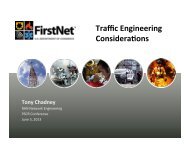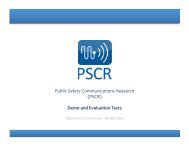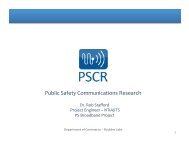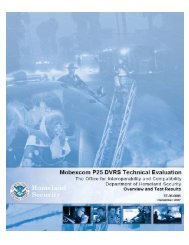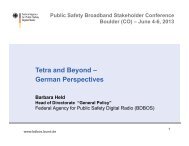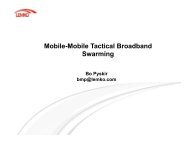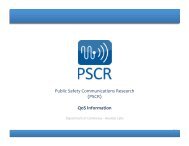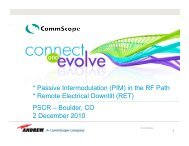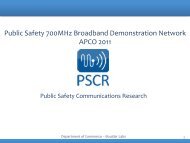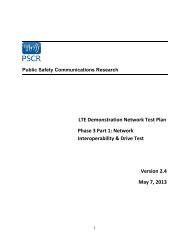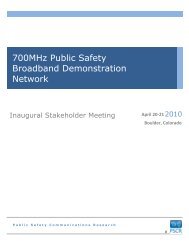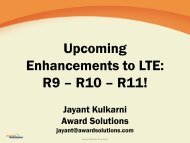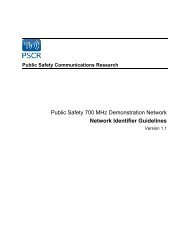Presentations - PSCR
Presentations - PSCR
Presentations - PSCR
Create successful ePaper yourself
Turn your PDF publications into a flip-book with our unique Google optimized e-Paper software.
APCO International Annual Conference 2013<strong>PSCR</strong> CURRENT EFFORTSJeff BratcherOperations ManagerAugust 20 th , 2013
Public Safety CommunicationsLocated at the Department of Commerce Boulder Labs in Colorado The <strong>PSCR</strong> Program is a joint effort between: NIST’s Office of Law Enforcement Standards (OLES) and NTIA’s Institute for Telecommunication Sciences (ITS) Research Program
<strong>PSCR</strong> Funding SourcesDepartment of HomelandSecurityOffice for Interoperability andCompatibilityOffice of EmergencyCommunication
DisclaimerThe full descrip.on of the procedures used in the following <strong>PSCR</strong> presenta.ons require the iden.fica.on of certain agencies, locali.es, commercial products and their suppliers. The inclusion of such informa.on should in no way be construed as indica.ng that such agencies, products or suppliers are endorsed by <strong>PSCR</strong>, or are recommended by <strong>PSCR</strong>, or that they are necessarily the best materials, instruments, so@ware or suppliers for the purposes described.
<strong>PSCR</strong> Current Efforts Requirements Standards 700 MHz Public Safety Broadband Demonstra.on Network Modeling & Simula.on
Requirements: Past Efforts• 2004 SAFECOM Statement of Requirements – Who, what, why, when opera.onal understanding • 2007 Na.onal Public Safety Telecommunica.ons Council (NPSTC) Broadband Working Group (BBWG) Statement of Requirements • 2009 NPSTC BBWG Task Force Report – Public safety selects LTE, LMR model for procurement and opera.on • 2011 Mission Cri.cal Voice Requirements – BBWG seeks to define features/func.ons that make up mission cri.cal voice • 2011-‐2012 NPSTC BBWG Task Group Efforts – Priority/quality of service – Local control • 2012 NPSTC BBWG Statement of Requirements – Submi_ed “Launch Requirements” for FirstNet • 2013 NPSTC PTT Over LTE Requirements document published
Requirements: NPSTC BBWG NextSteps• Requirements development next steps – Quan.fy FirstNet launch requirements – Stage 2 (1-‐2 year) qualita.ve requirements – Console requirements: dispatch and call taking – Video requirements: quality and interoperability – Public safety grade requirements • Global strategy: partner with Europe, Canada, Australia
Broadband Standards: Current Efforts2. NPSTC developsrequirements for gap andliaises with ATIS1. <strong>PSCR</strong>recognizes apublic safetyrelevant gap3. <strong>PSCR</strong>participates inATIS andrepresentsFirstnet4. ATIS liaises with3GPP/GSMA for newwork effort5. <strong>PSCR</strong>participates in3GPP/GSMA andrepresents Firstnet
Standards Continued: 3GPPStructureTechnical Specifications Group (TSG) StructureTSG GERANGSM EDGE RadioAccess NetworkGERAN WG1Radio AspectsGERAN WG2Protocol AspectsGERAN WG3Terminal TestingTSG RANRadio AccessNetworkRAN WG1RL 1 SpecRAN WG2RL 2 SpecRL 3 RR SpecRAN WG3Lub, lur, lu specsUTRAN O&M ReqsRAN WG4Radio PerfProtocol AspectsRAN WG5Mobile TerminalConformance TestingTSG SAService &Systems AspectsSA WG1ServicesSA WG2ArchitectureSA WG3SecuritySA WG4CodecSA WG5Telecom MgtTSG CTCore Network &TerminalsCT WG1MM/CC/SM (lu)CT WG3Interworking w/ Ext networksCT WG4MAP/GTP/BCH/SSCT WG6Smart Card App Aspects
Broadband Standards: Current Efforts Broadband Standards: Current Efforts• Current Focus – 3GPP – TBD • Proximity Services/ProSe (Talk-‐around) • Group Efficiency (Group communica.ons) • PTT over LTE (Push-‐to-‐talk over LTE) – GSMA • VoLTE (Voice over LTE) • Lessons Learned – Public safety LTE is a global market; <strong>PSCR</strong>’s global partnerships have been successful
Standards: Proximity Services• Proximity Services (ProSe) – What it is • The equivalent of direct mode or talk around in Land Mobile Radio terminology. It has 2 main aspects: – The Strategy – Discovery: ability to discover if other UE of interest is in physical proximity – Communica.ons: ability to directly communicate with 2 or more UEs in physical proximity without infrastructure • Public safety vs. commercial: prevent development of separate solu.ons, maximizing use of commercial products • Global: coordinate with global public safety community (cri.cal to drive unified standards solu.on) – The Risks • Some commercial operators are expressing interest in public safety; most are disinterested in ProSe from a commercial perspec.ve
Standards: Group Communications• Group Communica.ons System Enablers (GCSE) – What it is • Making the 3GPP ecosystem more group aware, allowing more efficient group and broadcast communica.ons by forcing 3GPP RAN and EPC to track group membership in addi.on to UE loca.on and facilitate group communica.ons setup – The Strategy • Push as much of this work into 3GPP as possible, making standards based solu.ons globally available for all public safety operators given opera.ng needs (most communica.ons are group based) • Expand this work into commercial areas (social network, gaming, etc.) as much as possible to grow market opportunity – The Risks • Some vendors are trying to limit level of group awareness in 3GPP • This will lead to proprietary group enablement across each group based applica.on/service deployment, increasing procurement and opera.ons costs, and maintenance of mul.ple group management systems
LTE Network Architecture• Spectrally Efficient (OFDMA) • Mul7ple Antenna Techniques (MIMO) • IP Based Access Network • De-‐centralized radio network controller • IP Oriented • Scalable & Distributed Network Design • IP Mul7media System (IMS) – Voice/SMS • Over-‐The-‐Top (OTT) • Internet AirInterfaceRadioAccessNetworkEvolvedPacketCoreNetworkServiceNetwork
<strong>PSCR</strong> Demo Network: Current Efforts • Obtain, procure, and generate interest from broadband vendors to develop a 700 MHz broadband equipment ecosystem -‐ including Band Class 14, Long Term Evolution (LTE) • Demonstrate broadband air-‐interface and core network capabilities • Interoperability with existing cellular, broadband and LMR technology • Validation of key public safety functionalities and requirements • Modeling & Simulation of various potential public safety LTE deployments • R&D na7onwide interoperability through a unified approach to network design and implementa.on – Tes.ng (conformance, performance and evalua.on) – Mul.-‐site/vendor Over-‐The-‐Air network – allows consistent tes.ng between vendors – Develop guidelines/industry requirements for network architecture – Advanced feature tes.ng
<strong>PSCR</strong> Boulder Sites • <strong>PSCR</strong> Demonstra.on network cellsites: Green Mountain Cellsite On Wheels (COW) Table Mountain Mesa
<strong>PSCR</strong> Boulder Sites Site locations for the Boulder Demo Network: A. Green Mountain • Dept. of Commerce Labs B. Table Mountain Mesa (9 miles NE of DOC Labs) • Radio Quiet Zone • Managed by NTIA/ITS B.C. Cell on Wheels (COW) • Currently at GunBarrel A.
Green Mountain Base Station
Table Mountain Mesa
Table Mountain Mesa (inside)
Cellsite on Wheels (COW)
GunBarrel Co-‐Located Cellsite
Network Modeling: Current Efforts• Evaluate the performance of Long Term Evolu.on (LTE) networks and their capacity to support Public Safety requirements – Op.mize different scenarios for the demonstra.on network – Es.mate the resources required to build a na.onwide public safety broadband network – Define performance metrics to facilitate the comparisons of network scenarios and deployments – Obtain area, popula.on, and user coverage – Determine maximum supported capacity
Public Safety Broadband Research &Development RoadmapKey Objec7ves • Highlight the needs for public safety broadband R&D beyond the short term horizon (18-‐24 months); • Begin to iden.fy research areas that need to be developed over the long term (5-‐10 years) in order for a public safety broadband network to fulfill its ul.mate goals; • Provide the <strong>PSCR</strong> with the informa.on needed to plan and make investments in staff and equipment so that the program is prepared to target its’ research towards public safety’s requirements in both the short and long term; • Be created through a stakeholder-‐driven process that will take into account input from public safety, industry, government, and academia; and, • Be the “community’s” roadmap. The roadmap will be a public document to be used by public safety, industry, and other government agencies as they inves.gate and plan around the long-‐term future of public safety broadband communica.ons. <strong>PSCR</strong> Public Safety Broadband R&D Roadmap Project TimelineJul Aug Sept Oct Nov Dec JanPublic Safety / State &Local InterviewsIndustry & AcademiaInterviewsStakeholderWorkshopFinalRoadmap
Public Safety Broadband Research &Development RoadmapConnec7ons with FirstNet • <strong>PSCR</strong> is aligning with FirstNet ac.vi.es and other key ini.a.ves to ensure comprehensive input for the roadmap. • FirstNet will par.cipate in the stakeholder workshop, engaging public safety and industry in discussions on how key requirements iden.fied by public safety may be addressed in the short term (2-‐5 years).
2013 Public Safety BroadbandStakeholder Conference Highlights• Meeting well-‐attended: 450 attendees, including FirstNet board members, employees and consultants • FirstNet – Strong message: FirstNet values input from First Responders, APCO, <strong>PSCR</strong>, etc. – Stakeholder outreach – RFIs (Request for Information) – SLIGPs (State and Local Implementation Grant Program) • Deployable Systems (several presentations) – Fixed or movable – Rural coverage – Backup for failed site or increased coverage when needed • Critical topics – Security – User and device authentication
2013 Public Safety Broadband StakeholderConference Highlights• <strong>Presentations</strong> related to possible future directions for <strong>PSCR</strong> testing – VoLTE (Voice over LTE) – eMBMS (evolved Multimedia Broadcast Multicast System) • Modeling and forecasting complications – Critical to characterize the number of First Responders in a given area – Complication: during an incident, multiple departments converge from multiple jurisdictions – Conclusion: Public Safety input, real-‐life examples critical to understanding requirements • For more information visit: www.pscr.gov/about_pscr/highlights/psbb
Contact InformationJeff Bratcher Opera.ons Manager jeff@its.bldrdoc.gov www.pscr.gov
Q & AFollow APCO at…facebook.com/apcointernational@apcointl



